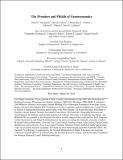| dc.contributor.author | Benjamin, Daniel J. | |
| dc.contributor.author | Cesarini, David | |
| dc.contributor.author | Chabris, Christopher F. | |
| dc.contributor.author | Glaeser, Edward Ludwig | |
| dc.contributor.author | Laibson, David I. | |
| dc.contributor.author | Guðnason, Vilmundur | |
| dc.contributor.author | Harris, Tamara B. | |
| dc.contributor.author | Launer, Lenore J. | |
| dc.contributor.author | Purcell, Shaun | |
| dc.contributor.author | Smith, Albert Vernon | |
| dc.contributor.author | Johannesson, Magnus | |
| dc.contributor.author | Magnusson, Patrik K.E. | |
| dc.contributor.author | Christakis, Nicholas Alexander | |
| dc.contributor.author | Atwood, Craig S. | |
| dc.contributor.author | Hebert, Benjamin Michael | |
| dc.contributor.author | Freese, Jeremy | |
| dc.contributor.author | Hauser, Robert M. | |
| dc.contributor.author | Hauser, Taissa S. | |
| dc.contributor.author | Hultman, Christina M. | |
| dc.contributor.author | Lichtenstein, Paul | |
| dc.contributor.author | Beauchamp, Jonathan P. | |
| dc.contributor.author | Grankvist, Alexander | |
| dc.date.accessioned | 2013-01-04T20:12:26Z | |
| dc.date.issued | 2012 | |
| dc.identifier.citation | Benjamin, Daniel J., David Cesarini, Christopher F. Chabris, Edward L. Glaeser, David I. Laibson, Vilmundur Guðnason, Tamara B. Harris, et al. 2012. The promises and pitfalls of genoeconomics. Annual Review of Economics 4:627-662. | en_US |
| dc.identifier.issn | 1941-1391 | en_US |
| dc.identifier.uri | http://nrs.harvard.edu/urn-3:HUL.InstRepos:10137000 | |
| dc.description.abstract | This article reviews existing research at the intersection of genetics and economics, presents some new findings that illustrate the state of genoeconomics research, and surveys the prospects of this emerging field. Twin studies suggest that economic outcomes and preferences, once corrected for measurement error, appear to be about as heritable as many medical conditions and personality traits. Consistent with this pattern, we present new evidence on the heritability of permanent income and wealth. Turning to genetic association studies, we survey the main ways that the direct measurement of genetic variation across individuals is likely to contribute to economics, and we outline the challenges that have slowed progress in making these contributions. The most urgent problem facing researchers in this field is that most existing efforts to find associations between genetic variation and economic behavior are based on samples that are too small to ensure adequate statistical power. This has led to many false positives in the literature. We suggest a number of possible strategies to improve and remedy this problem: (a) pooling data sets, (b) using statistical techniques that exploit the greater information content of many genes jointly, and (c) focusing on economically relevant traits that are most proximate to known biological mechanisms. | en_US |
| dc.description.sponsorship | Economics | en_US |
| dc.description.sponsorship | Sociology | en_US |
| dc.language.iso | en_US | en_US |
| dc.publisher | Annual Reviews | en_US |
| dc.relation.isversionof | doi:10.1146/annurev-economics-080511-110939 | en_US |
| dc.relation.hasversion | http://economics.cornell.edu/seminars/Dan.Benjamin.Annual%20Review%20-%20published.pdf | en_US |
| dc.relation.hasversion | http://www.neuroeconomics.nyu.edu/papers/Benjamin1.pdf | en_US |
| dash.license | OAP | |
| dc.subject | genetics | en_US |
| dc.subject | heritability | en_US |
| dc.subject | GWAS | en_US |
| dc.title | The Promises and Pitfalls of Genoeconomics | en_US |
| dc.type | Journal Article | en_US |
| dc.description.version | Accepted Manuscript | en_US |
| dc.relation.journal | Annual Review of Economics | en_US |
| dash.depositing.author | Laibson, David I. | |
| dc.date.available | 2013-01-04T20:12:26Z | |
| dc.identifier.doi | 10.1146/annurev-economics-080511-110939 | * |
| dash.authorsordered | false | |
| dash.contributor.affiliated | Hebert, Benjamin | |
| dash.contributor.affiliated | Purcell, Shaun M. | |
| dash.contributor.affiliated | Christakis, Nicholas A. | |
| dash.contributor.affiliated | Laibson, David | |
| dash.contributor.affiliated | Glaeser, Edward | |
| dc.identifier.orcid | 0000-0001-5547-1086 | |


